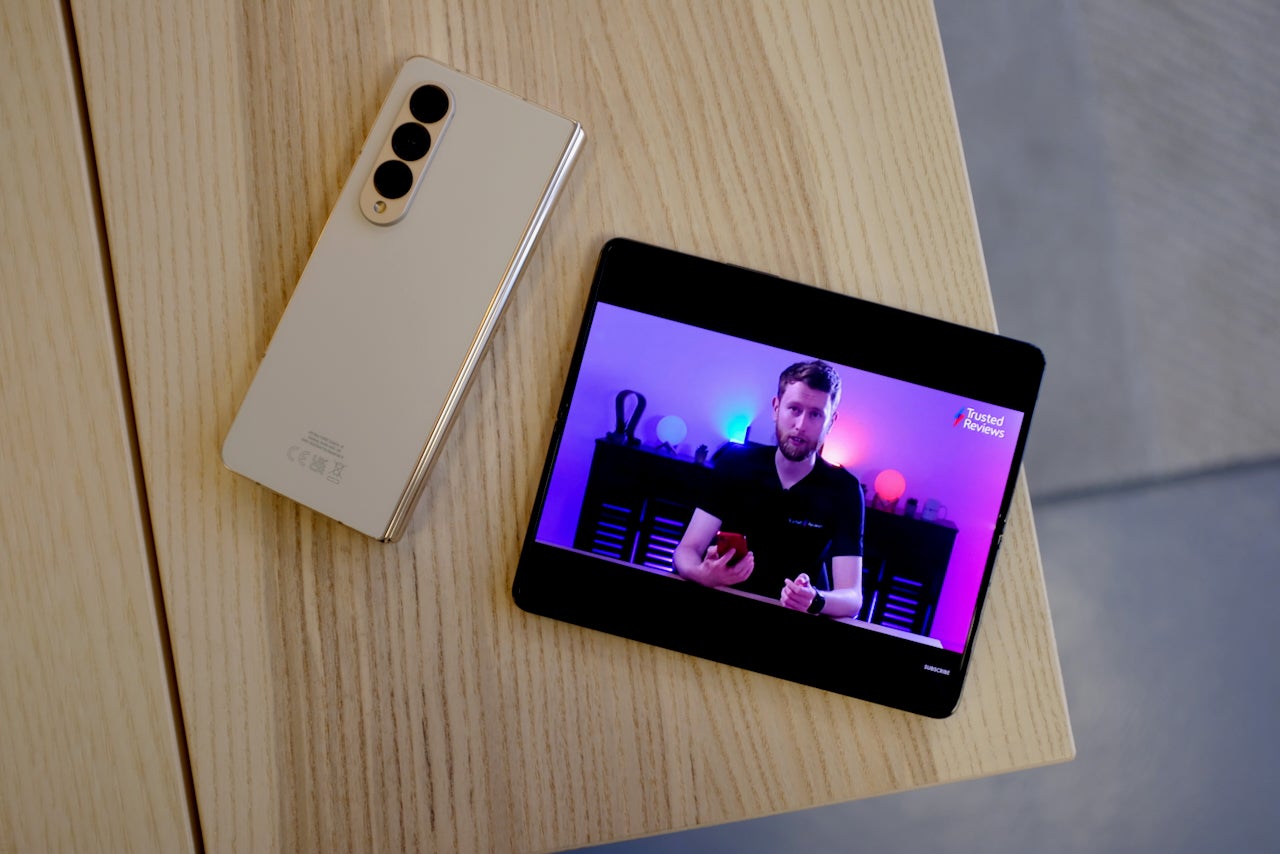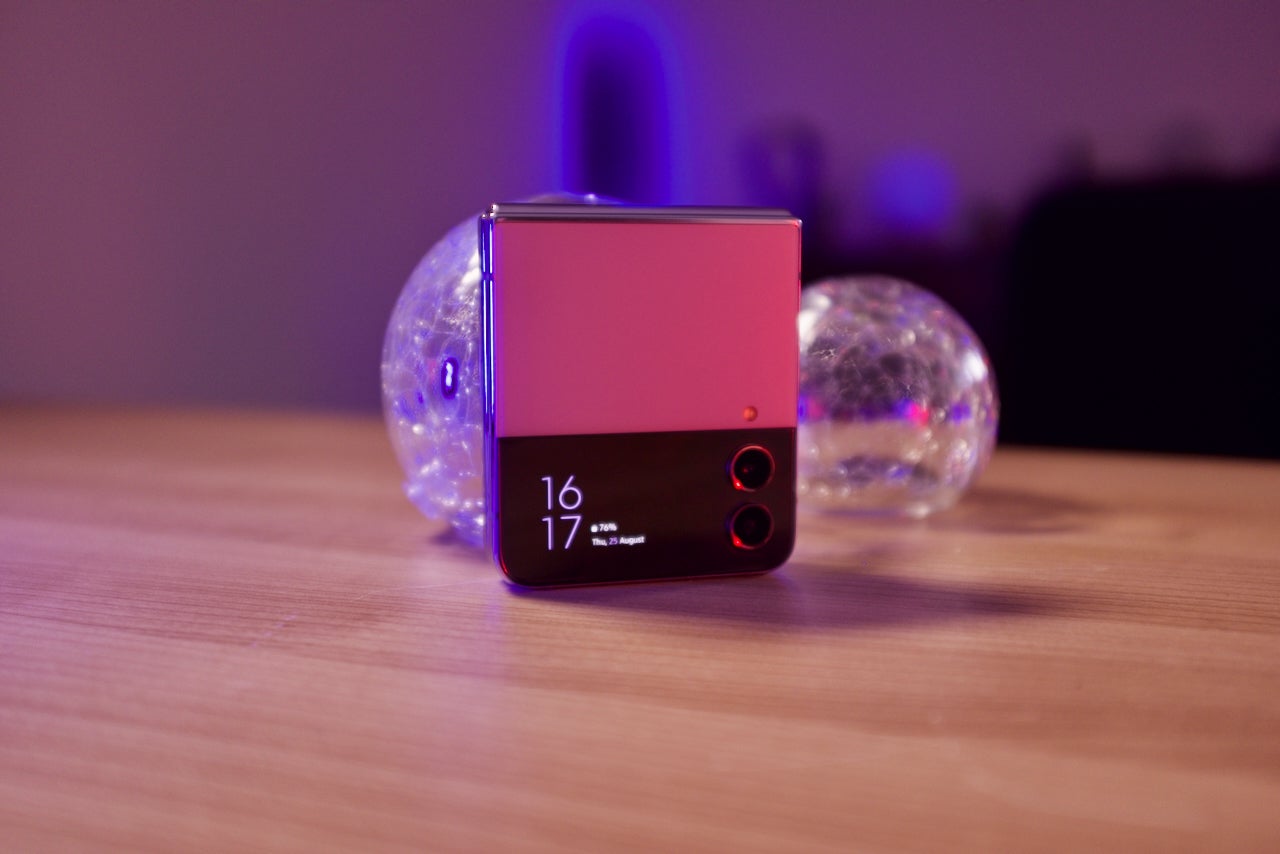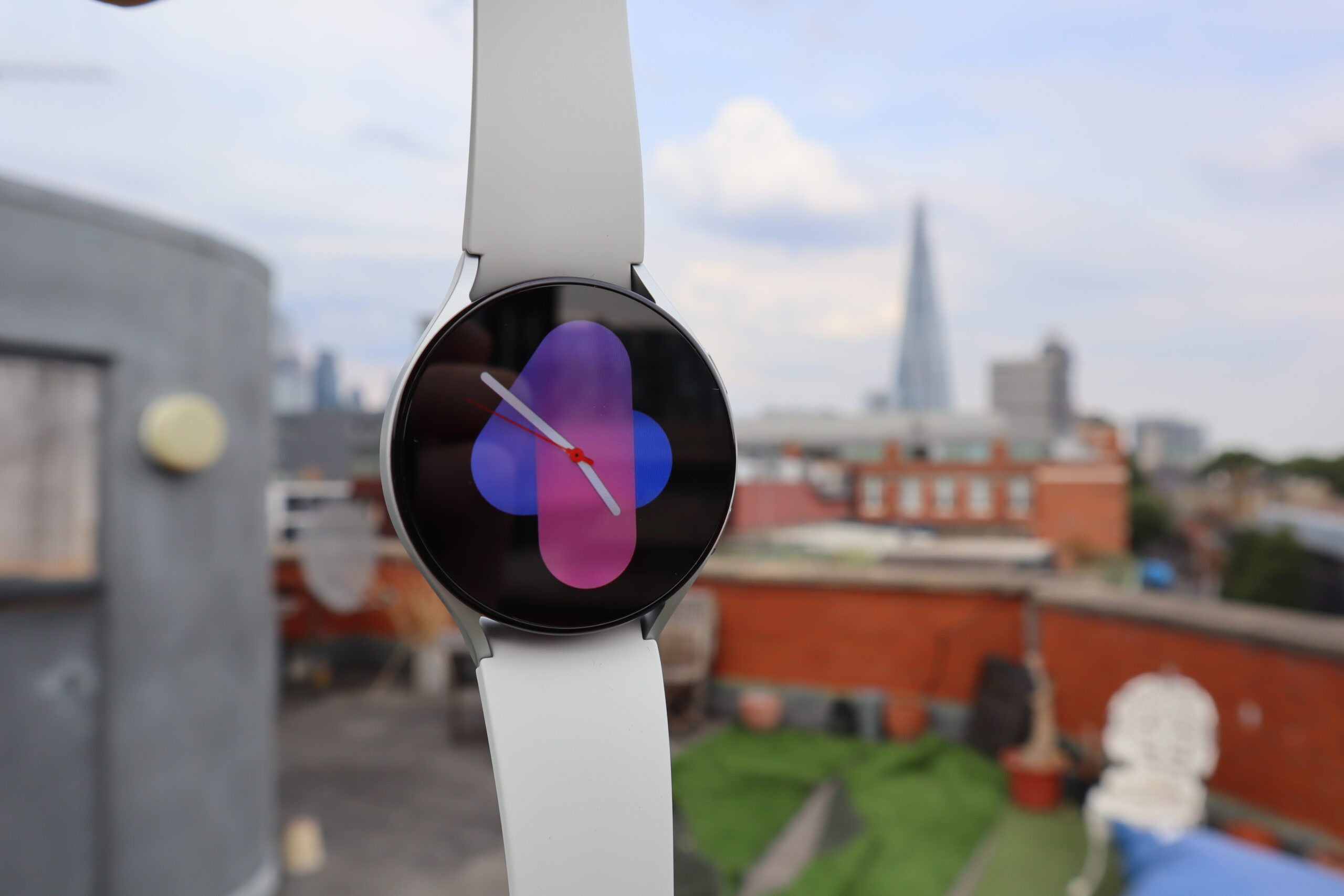Samsung Galaxy Watch 5 Pro Review
Samsung goes rugged
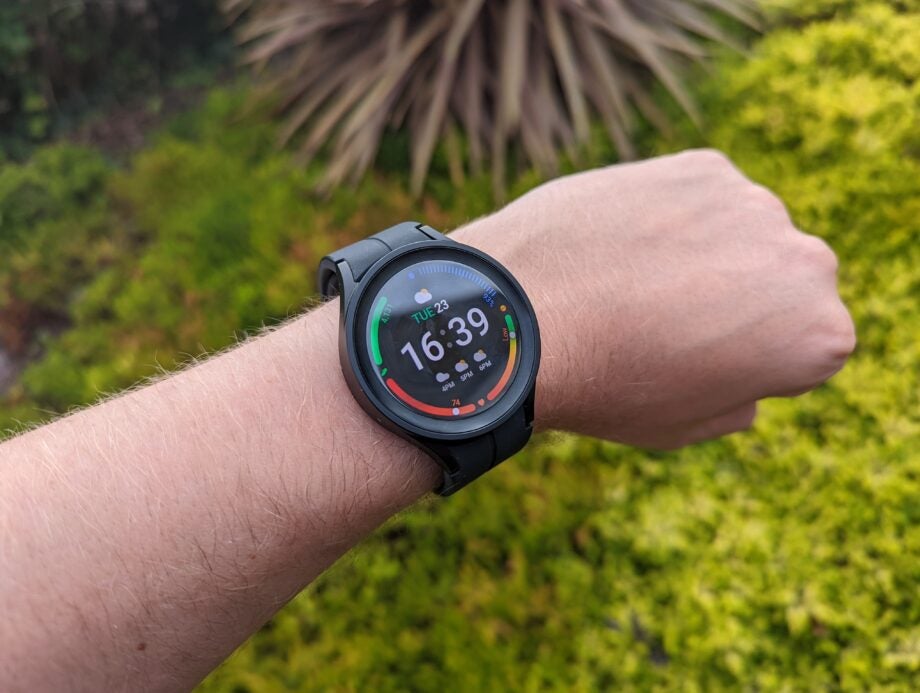

Verdict
The Galaxy Watch 5 Pro is one of the best Wear OS wearables currently available and a decent competitor to the Apple Watch 7 for any Android phone user. For the money you get a rugged smartwatch with a splash of advanced health and fitness tracking services traditionally only seen on more premium devices like the Garmin Forerunner 955. This makes the Galaxy Watch 5 one of the best all-round wearables on the market.
However, a number of small issues, like the inability to plan run routes on the watch itself and teething pains with Wear OS 3’s app support stop it from delivering on its initial promise of catering fully to serious athletes.
Pros
- Solid fitness tracking services
- Rugged, sports-ready design
- Wonderfully bright display
Cons
- Route planning process feels clunky
- Battery life doesn’t match rival fitness trackers
Availability
- UKRRP: £479
- USATBC
- EuropeTBC
- CanadaTBC
- AustraliaTBC
Key Features
- Rugged bodyEnhanced sapphire crystal screen and titanium body
- Big battery590mAh cell should get you through even the busiest of days
Introduction
The Galaxy Watch 5 Pro is the top dog in Samsung’s current line up of wearables. What makes it interesting is that rather than being pitched as an Apple Watch 7 rival, much like its sibling the Galaxy Watch 5, the Pro is being marketed to the hardcore fitness market.
Key additions include local route tracking, advanced post-workout performance and training analytics, the biggest battery we’ve seen on a Galaxy Watch and a new rugged titanium chassis designed for extreme workouts and sports.
With use of Google’s swish Wear OS 3 software, which Samsung debuted on last year’s Galaxy Watch 4, all of this gives the Pro the potential to be the first wearable I’ve tested to offer full fat smartwatch functionality and robust, serious athlete level fitness tracking.
After a week with the Watch 5 Pro I can confirm it is a very competent device and a great option for any Android user looking for a smartwatch that can double as a rugged fitness tracker to accompany them on outdoor adventures.
But a number of niggling issues stop it from being a better smartwatch than the ruling Apple Watch 7, or a true rival to dedicated trackers like the Garmin 955 Solar that I reviewed earlier this year, and which remains one of 2022’s best running watches.
Here’s why.
Design and screen
- The Galaxy Watch 5 Pro is more rugged than most smartwatches
- The Pro’s clasp is a little fiddly to get a tight fit on
- The screen is OLED, but it’s missing the Apple Watch 7’s VRR
The Galaxy Watch 5 Pro shares the same core DNA as its base Watch 5 sibling, which is in itself almost identical looking to last year’s Galaxy Watch 4. But taking it out of the box I immediately noticed a number of important differences that make its sports focus immediately apparent. Unlike the Watch 5, the Pro only comes in one 45mm size and black and grey colour options.
What sets it apart from the base Watch 5 is the use of a titanium bezel with raised edges, a harder sapphire crystal to protect the circular OLED display and an atypical clasp mechanism on the included strap. For those who really want to protect it, Samsung also sells a clip-on plastic case for the Pro, though this wasn’t included with my review unit.
Despite the lack of a case I’ve had zero issues with the Watch 5 Pro’s build quality during testing. Though it doesn’t feel quite as scratch resistant as the Garmin Fenix 7 that I was using before starting this review, with the black metal clasp picking up a small blemish on its finish when I accidentally scraped it across a wall while playing squash. Other than that, it’s survived every ordeal I’ve put it through.
This included a daily weight and exercise bike session, three 5km runs (two in heavy rain) plus general, everyday use. During this time the screen survived an encounter with a freeweight and the watch continued to operate optimally even when used in heavy rain.
The side-facing physical controls also have a nice tactile feel to them. On a fitness focussed device they are a particularly welcome addition that make it quick and easy to pause or stop workouts without having to use the touch screen which, like all the wearables I test, struggles to detect inputs from sweaty digits.
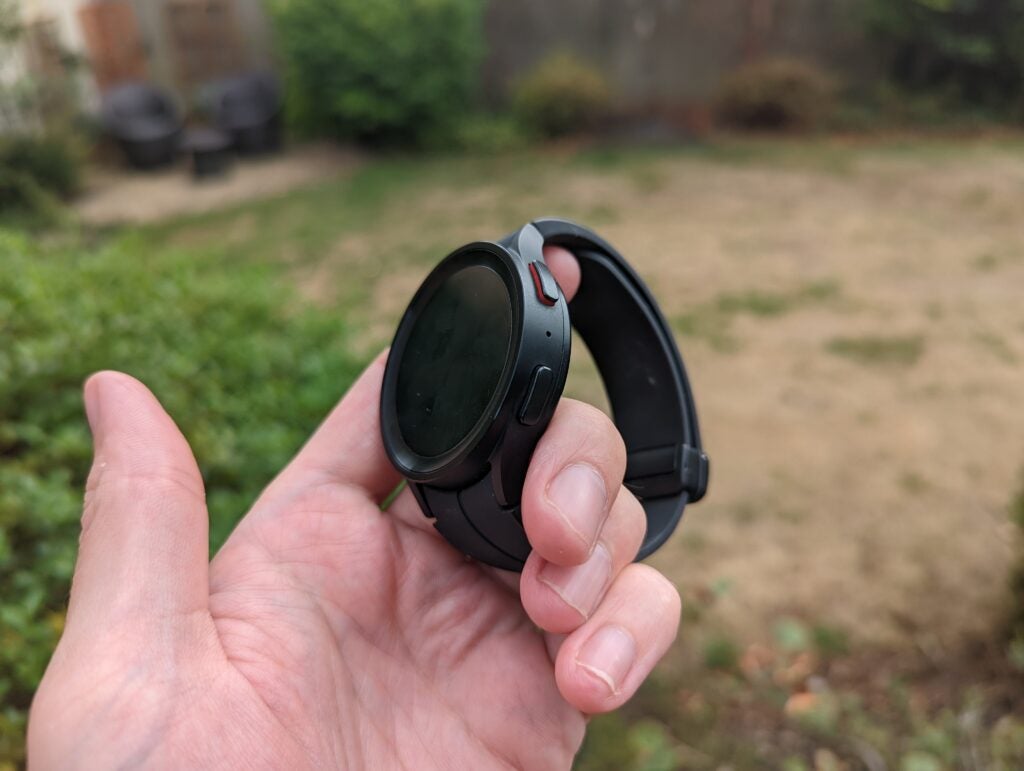
I’m also impressed how good the watch looks in spite of its rugged design and the wealth of hardware inside. Despite throwing everything but the kitchen sink at the Pro, and designing it to meet 5ATM, IP68 and MIL-STD-810H durability standards – the watch is a lot smaller than I expected.
And for the most part that makes it very comfortable to wear but I did encounter a few annoyances testing the Watch 5 Pro. The first stems from the included D-Buckle sport band and its atypical clasp mechanism. The mechanism is designed to make it easier to take the watch off by using a clasp rather than a traditional watch strap but it ends up being finicky in real world use.
To adjust the strap’s length you need to pop a secondary clasp and feed more or less of the band into it before closing. This makes it all but impossible to adjust the length mid-workout. I found this a pain as, given how your body expands and contracts for a variety of factors, it meant the watch would occasionally feel too loose or too tight mid-run.
The second annoyance relates to the Watch’s bezel, specifically the lack of a rotating function. A physical rotating bezel was one of my favourite things about the Galaxy Watch 3. It let you switch between screens, adjust slider controls and much more without needing to engage with the touchscreen. For reasons unbeknownst to me Samsung semi-retired the function on the Galaxy Watch 4 by making it only available for the Galaxy Watch 4 Classic, and now it hasn’t returned it back for the Watch 5 series, period.
In its place is a digital scroll that occurs when you circle the display with your finger, providing haptic feedback in return to mimic the feel of that beloved rotating bezel. It’s functional but but imperfect, particularly when sweat is thrown into the mix.
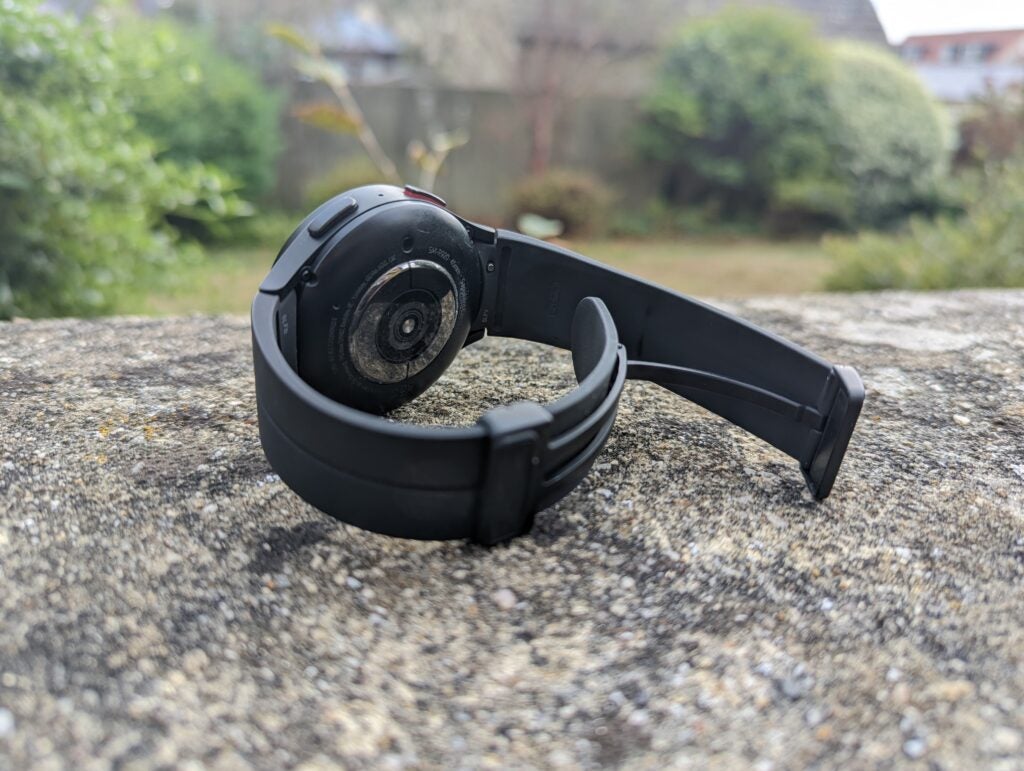
The third and final annoyance I experience stemmed from the OLED panel’s lack of a variable refresh rate. This is a technology enjoyed on premium Apple Watches that aims to boost battery life. It works by letting a screen adjust how many images per second it displays based on the process being run. So, for example, when it’s just telling the time, it can lower to only show one image per second, rather than 60, which is most screen’s default refresh rate.
Though the Apple Watch 7 isn’t praised for its battery life, with it struggling to last more than one or two days off a single charge, it was a key selling point that at least helped to extend it. Considering the Watch 5 Pro’s sports focus and price, I’d have liked to see the tech make an appearance.
The Watch 5 Pro’s Super AMOLED screen is otherwise excellent. The spherical display is one of the brightest I’ve seen on a wearable. During testing I never had any issue reading it, even when using the Watch 5 Pro in direct sunlight. The inky perfect black levels offered by AMOLED screens also made it look vibrant and generally pleasant to use. Text and icons are also large enough to be easily readable though, like all watches, the screen’s too small to comfortably read longer incoming messages.
Tracking and features
- The Galaxy Watch 5 Pro features local mapping and GPX file support for trail runners and cyclists
- The Galaxy Watch 5 Pro features robust health tracking including ECG heart and body composition measuring
As ever, though a watch may look nice, it’s the software that dictates its longevity. At its heart the Galaxy Watch 5 Pro has the same core feature set as the Galaxy Watch 5. This means it runs on a customised version of Google’s Wear OS 3 that at first glance is all but identical to the version we tested on last year’s Galaxy Watch 4.
The UI is fairly intuitive, and heavily reliant on touch inputs. Setting up the 5 Pro you’ll be offered a variety of watch faces, each of which have their own unique style. They also make use of different complications, with information including your heart rate, step count and the weather forecast. From there the watch has a widget focussed UI that lets you swipe left to navigate through various tiles.
One of the most useful is the Samsung Health tile. This works the same way it did on the Galaxy Watch 4 and gives an instant overview of your daily activity and how far you are from hitting your targets. It’s a useful feature if you want a quick update of how close you are to hitting your fitness goals on the fly.
There’s also support for local music playback thanks to Wear OS’ app library which includes Spotify. The only downside is that some services, like Tidal, still don’t have optimised apps. This is indicative of a wider issue on the platform, with the Watch 5 Pro having a significantly smaller selection of key apps than what I found on the Apple Watch. Things like the Met Office weather app still weren’t on offer during my review period, for example.
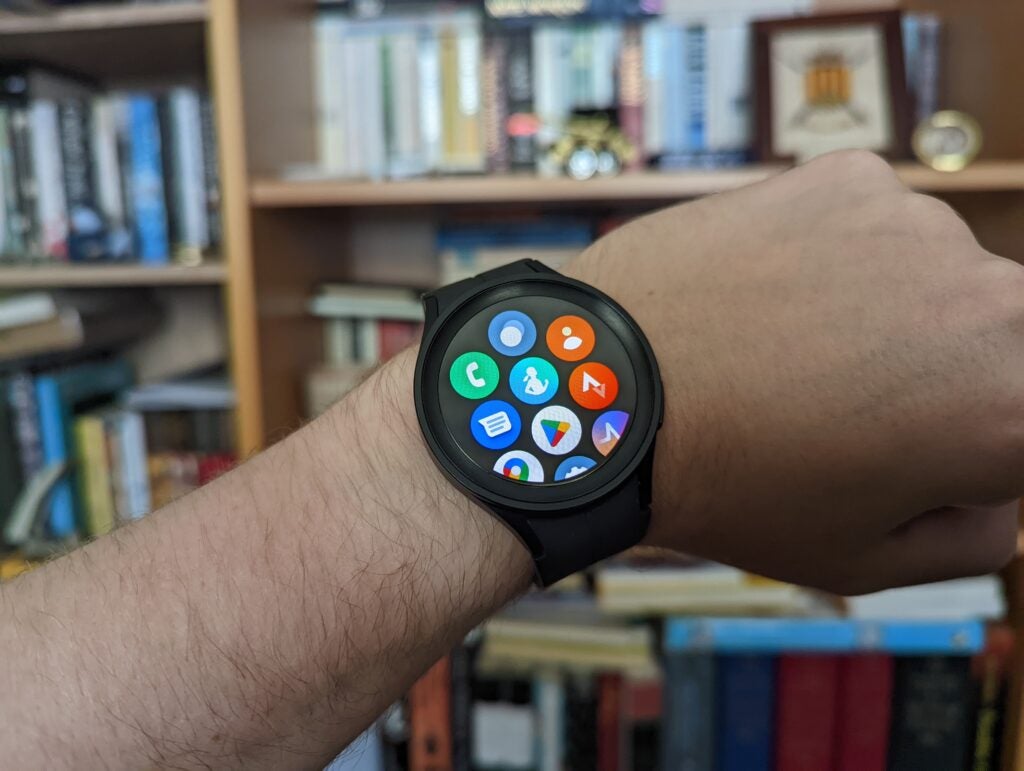
Despite this it still performed admirably as a smartwatch, pushing notifications and letting me control my music reliably throughout my time with it. My only minor quibble is that out of the box the Watch uses Samsung’s own Bixby digital assistant, which isn’t anywhere near as smart as Google’s own.
Even though the Watch 5 Pro’s speaker and mic worked when I did basic checks with Bixby, the assistant regularly had issues with performing simple tasks. A good example was in trying to control my hue lights. During my tests I couldn’t get Bixby to connect with them, whereas I could with Google Assistant.
What differentiates the Pro from most other smartwatches are its advanced fitness tracking services. By default these are handled by Samsung Health, rather than Google. However, the use of Wear OS means you can easily switch it to use third party services like Strava or Runkeeper simply by downloading the apps.
The core offering is identical to the base Galaxy Watch 5, which means you get a 3-in-1 BioActive sensor and a new infrared temperature sensor.
Via the BioActive sensor, you can get information on things like your body fat and skeletal muscle to get an overview of your health. It works by running a series of tests when you place your index and ring finger on the watch’s physical keys. It’s a useful metric for people aiming to build muscle or lose fat that, with it being the type of information you’d only have if you invested in a smart scale like the Withings Body+. The only downside I’ve found is that the measurement process is very fiddly, with the watch requiring you to stay very still while it takes your measurements.
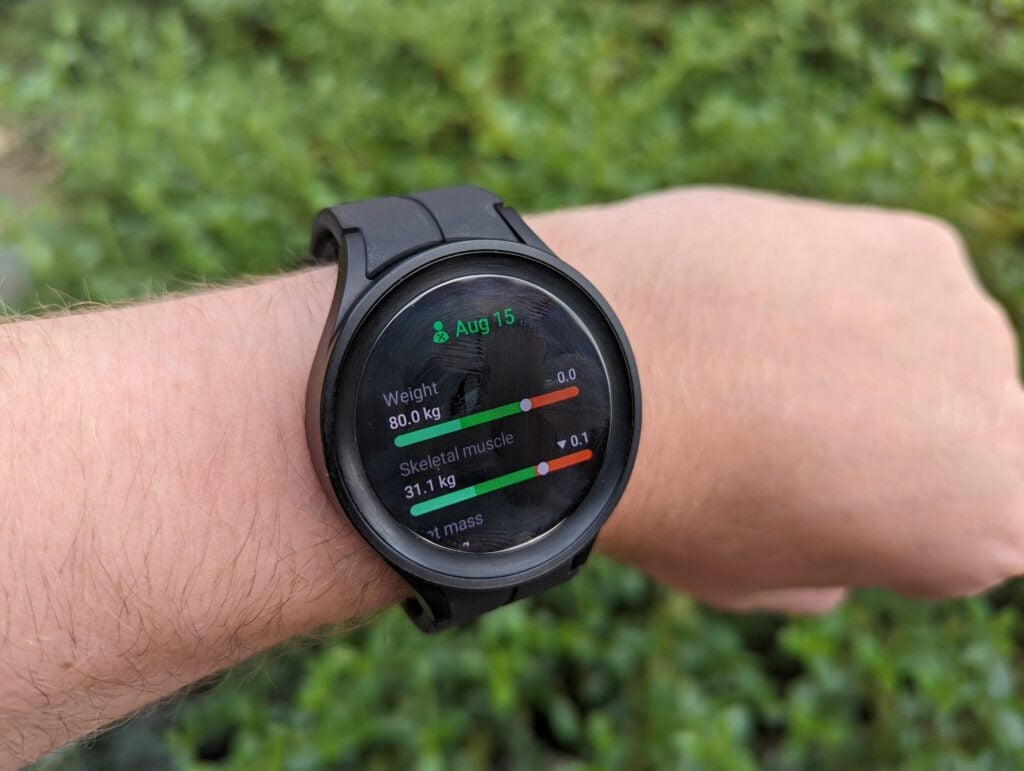
The temperature sensor is a new addition for both the Watch 5 and Pro, a feature that previously appeared on the Fitbit Sense a couple of years ago and I was excited to see how it worked here. Sadly, at the time of writing it didn’t seem to be used at all, with the Pro and Health app not showing any data from the sensor. Hopefully this will be fixed in the near future. I’ll update this review when it does.
Sleep tracking also works the same as the Watch 5, with it offering basic metrics, like how much deep sleep I got as well as more advanced coaching services. Specifically, the Watch 5 Pro will offer you advice on how to sleep better using detailed recommendations like the one pictured below. This will be a boon for people who are poor sleepers such as myself, with the scores offering clear advice on issues and how to fix them.
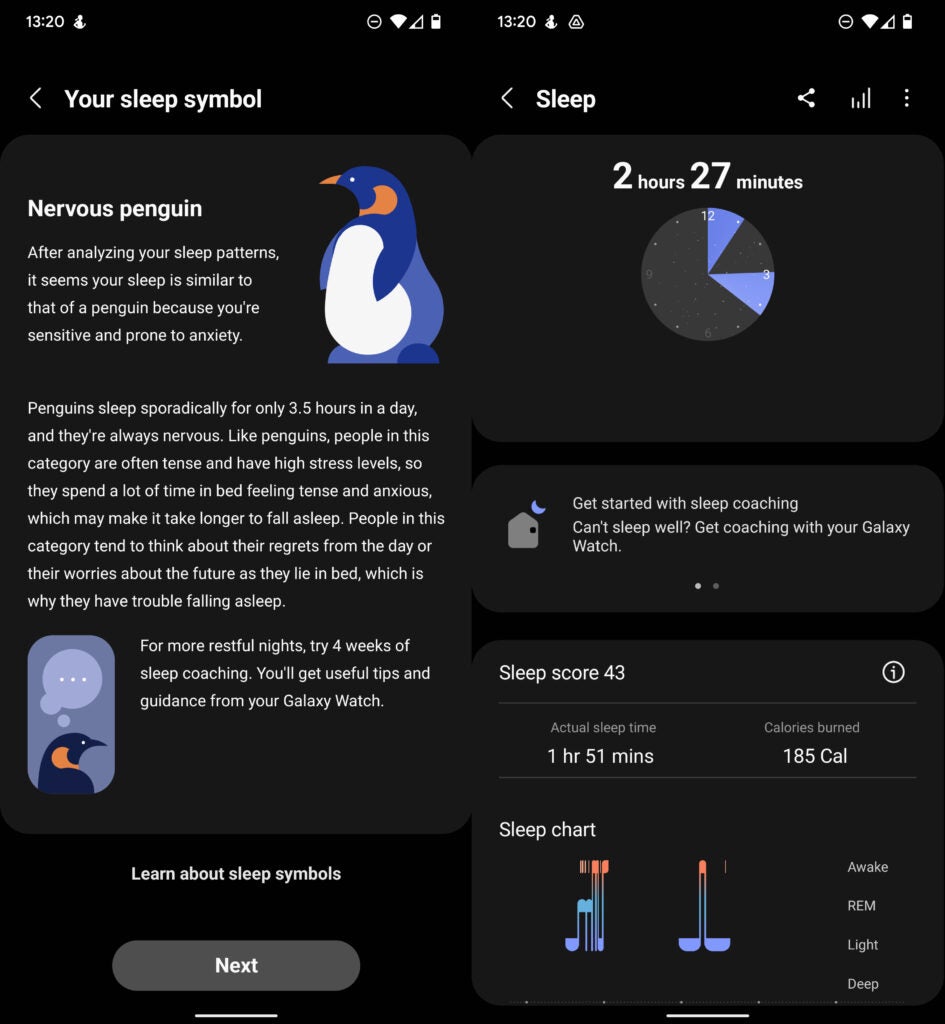
What sets the Pro apart from its base Watch 5 sibling are the additions of turn-by-turn route navigation and a new “track back” feature. These features are aimed at more serious athletes and traditionally only seen on hardcore fitness trackers, like the Forerunner 955. In theory they let you get local, turn by turn navigation on new run and cycling routes from the watch, ensuring you don’t get lost when exercising in a new area or while exploring the countryside.
When I got the features working, the route planning was a treat. Using it to plot a cycle around Wiltshire, the GPS and mapping software gave clear advice, ensuring I was able to do a quick 10km without stopping or having to check for directions. The issue is when the route tracking doesn’t want to play ball to begin with.
Turn by turn navigation is usually powered by a GPX file that tells the watch the route you’ve plotted. The Watch 5 Pro does support these types of files, but the problem is that the device and the Samsung Health App don’t actually have a GPX creation tool built in. This meant that in order to test the feature I had to go into a third party app on my laptop (via paid Strava), create the file there and then transfer it to the Samsung Watch.
This sounds like a small nuisance but it made the entire process feel tiresome after a while. Garmin Connect has the functionality built in and it’s free, so the absence of the functionality in Samsung’s service feels a little odd. On top of that, even with the file made, Samsung’s wearable only lets you utilise it to track hikes and cycling activities – there’s no run support.
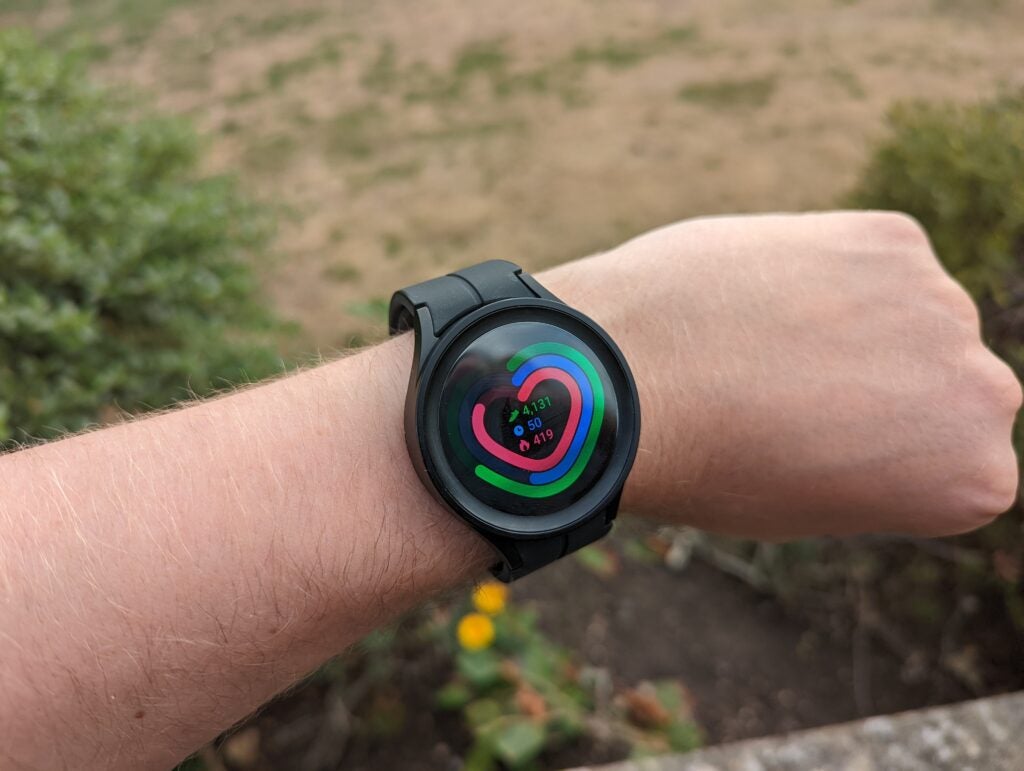
This is a shame as activity tracking is otherwise fairly impressive. Doing a course that I know is roughly 5.5km, the watch was never more than 0.1-0.2km off. I also didn’t notice any serious anomalies in the heart rate information it detected outside of HIIT sessions. Though being fair, every wrist based sensor struggles to keep up with the rapid fluctuations in heart rate that occur during HIIT. Outside of this the data collected on the Watch 5 Pro was in line with what I got on the HRM strap I used as a reference point.
Though it’s not quite as detailed as what you’ll get on the Garmin Fenix 7 and Forerunner 955, post workout analytics are also solid and much better than what you’ll find on the Apple Watch 7. As well as heart rate zones, which give an indication of what benefit you got from your workout, it’ll offer key metrics including a VO2 Max estimate. Running for example will rank you on things like contact time and stiffness, which in turn helped me spot weaknesses in my form.
If I was to have one quibble with the Pro’s tracking features, it’d be that while the data is there, it’s not presented in quite as clear a way as what I get using Garmin devices. Samsung gives you the data you need to tell if you’re overtraining, but you need to know how to read it. I’d personally have preferred a more direct method to show it, like Garmin’s recovery time which tells you exactly how many hours or days you need to rest before your next workout. Small changes like this would make the watch much more accessible for new or semi-serious runners.
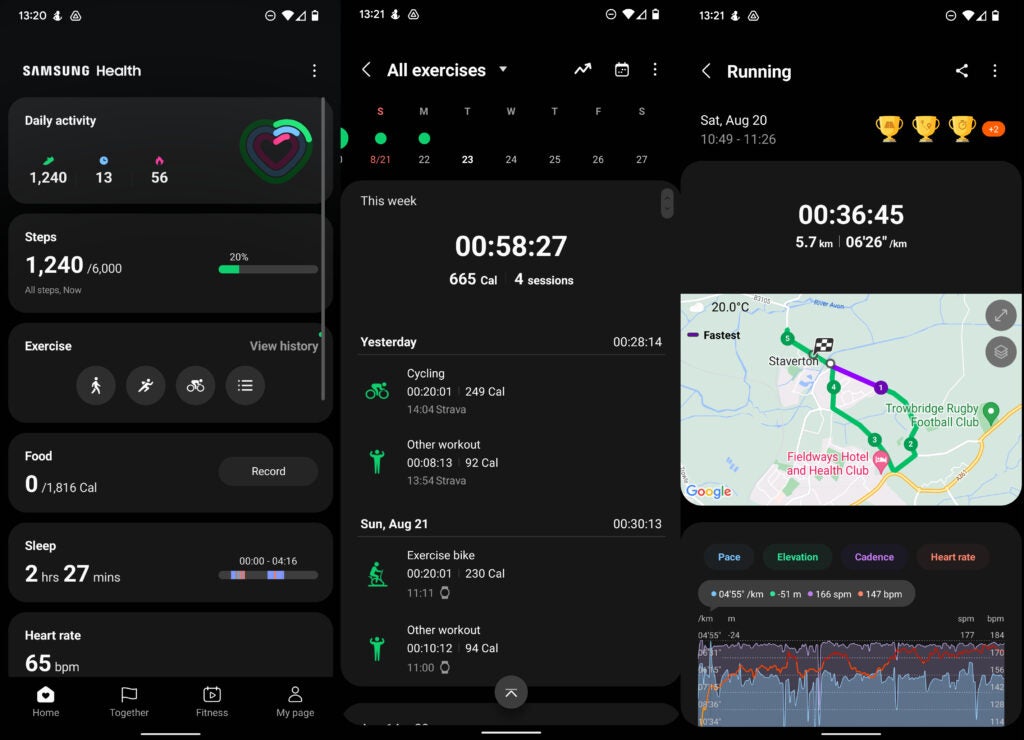
Battery life
- Despite having a bigger battery than most smartwatches, it still only lasts 2-3 days with moderate use
- GPS puts a big drain on the battery, but it still lasts longer than an Apple Watch when tracking activities
- Charging faster than last year’s model, but still slower than I’d like
Battery life is a regular issue when we review smartwatches. We have yet to review a Samsung Galaxy Watch or Apple Watch that can reliably last more than a few days of use. This is a far cry short of the multi-week battery life you’ll find on fitness trackers from Garmin and Polar.
Samsung’s tried to reverse this trend on the Galaxy Watch 5 Pro, loading it with a giant 590mAh battery that’s close to twice the capacity of what you’ll find on the base Watch 5.
However, during testing I found that it still only offers around two day’s regular use. This entailed using the Watch to keep on top of incoming notifications, tracking my 30 minute morning cardio session and one 5km run per day with the watch’s always-on display option switched off.
With heavier use of the GPS when doing an extended hike I found the Watch 5 Pro at times would discharge as much 8-10% of its charge.
To be clear, these figures are decent for a smartwatch. The only downside is that they are well below what you’ll get on a dedicated tracker like the Forerunner 955 which is a direct rival in the fitness market.
Charge speeds are also good but not best in class. Connecting the included cable to a fast charging plug, the battery went from 0-38% in 15 minutes which is good, but it then took a full 1 hour 22 minutes to make its way up to 100%.
If you want to use the always-on display then be warned that it’ll cost you an extra 3% of your battery per hour, based on my usage.
Latest deals
Should you buy it?
You should buy the Galaxy Watch 5 Pro if you want a decent smartwatch that can double as a fully functioning fitness tracker. The Galaxy Watch 5 Pro features full fat smartwatch functionality and a selection of fitness features, like route planning, traditionally only seen on dedicated trackers. This makes it a great option for serious athletes that want the best of both worlds.
You shouldn’t buy the Galaxy Watch 5 Pro if you are a hardcore runner. Though the Galaxy Watch 5 Pro has decent services and tracking mechanics for most sports, its battery life and issues with local route planning make it a poor choice for more serious joggers.
Final Thoughts
The Galaxy Watch 5 Pro is an interesting wearable that tries to offer full fat smartwatch functionality alongside a series of fitness tracking features traditionally reserved for top end fitness trackers from the likes of Garmin, Polar and Suunto.
During my time with it I’ve found that it generally manages to offer good, but not best in class, performance in both areas. As a smartwatch it is without a doubt the most developed Wear OS option on the market, offering decent smartwatch functionality, local music playback and a wonderfully clear and bright OLED display. But Wear OS still doesn’t have the developed app library you’ll find on Apple’s watchOS, with key things like a Tidal app missing during my review period.
As a fitness tracker it’s great for most users, with it featuring all the sensors you need to get detailed post workout reports that actually help you to improve your fitness. But the route support is a little fiddly to set up, especially compared to Garmin’s service, which had me pinning to go back to using the Fenix 7 when plotting new courses.
How we test
We thoroughly test every smartwatch we review. We use industry standard testing to compare features properly and we use the watch as our main device over the review period. We’ll always tell you what we find and we never, ever, accept money to review a product.
Worn as our main smartwatch during the testing period
Heart rate data compared against dedicated heart rate devices
Side-by-side GPS comparison with our best scoring smartwatches
FAQs
The Galaxy Watch 5 Pro does not have an LTE option. It relies wholly on a smartphone connection for its smartwatch functions.
The Galaxy Watch 5 Pro has a 5ATM rating, this means it can survive at depths of up to 50 meters.
The Galaxy Watch 5 Pro runs on Google’s WearOS 3, which does feature a Spotify app.
Full specs
You can see a breakdown of the Galaxy Watch 5 Pro’s specs and how they compare to the base Galaxy Watch 5 and Apple Watch 7 in the table below.
Sustainability
TrustedReviews’ holds the fact that global warming is not a myth as a core value and will continuously endeavor to help protect our planet from harm in its business practices.
As part of this mission, whenever we review a product we send the company a series of questions to help us gauge and make transparent the impact the device has on the environment.
We currently haven’t received answers to the questions on this product, but will update this page the moment we do. You can see a detailed breakdown of the questions we ask and why in our sustainability info page.

